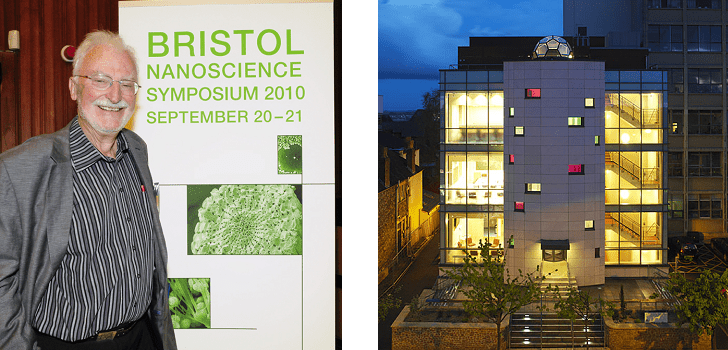By Louise Mayor
This week I was at the scientific opening of the Centre for Nanoscience and Quantum Information (NSQI) at the University of Bristol. The event coincided with the Bristol Nanoscience Symposium 2010, and featured great talks from some of the pioneers of nanoscience and nanotechnology.

(Left) Nobel Laureate Heinrich Rohrer declared the centre officially open. Photo credit: Jesse Karjalainen. (Right) The NSQI centre itself – the labs are out of sight and sound in the basement. Can you spot the nano-inspired architectural feature?
At the opening event on Monday evening, IBM Fellow Charles Bennett talked about how to make quantum information “more fun and less strange”. His educational analogies included the idea of monogamy in quantum information – that the more entangled two systems are with each other, the less entangled they are with any others. “The lesson is this: two is a couple, three is a crowd”, he said. He also talked about how information doesn’t get lost in quantum systems but does in classical ones – how it’s like there are eavesdroppers, and it’s harder to factorize when someone’s looking over your shoulder.
The stage was then passed over to Heinrich Rohrer (pictured), a figure revered by many in the audience. It was Rohrer, along with Gerd Binnig, who invented the scanning tunnelling microscope – an instrument that can image and manipulate single atoms – for which they were co-recipients of the Nobel Prize in Physics in 1986. Rohrer was at the time at IBM’s Zurich lab.
Rohrer commented about the “nano” revolution – that some say it’s hype, while others are more relaxed about it. “Let us not make a discipline out of ‘nano’ ”, he warned. He also said that the new trend is for people to operate using claims and catchphrases rather than careful explanations; he noted that in all his reading of Einstein’s papers he never once found words such as “new” or “unique”.
In his closing comments, Rohrer proposed a litmus test for the centre’s success. He said that if the NSQI can attract a good number of female nanoengineers and nanomechanics then it is a good sign of interesting research being done at the centre – and then you’re on the right track for the future. He then declared the centre officially open, and we all piled in to the centre for champagne and a tour of the labs, which are described in a previous blog entry: Visiting the quietest building in the world.
But for me, the most exciting talk was given the following day by Stanley Williams of Hewlett-Packard (HP)…
Williams talked about “memristors”, a new type of memory device first discovered in 2008, which make up the fourth missing electronic component in the group that also includes the resistor, capacitor and inductor. The memristor has a functionality that cannot be mimicked using any combination of resistors, capacitors or inductors – it can “remember” the amount of charge that has passed through it, and as a result change its resistance. Teaming up with Hynix Semiconductor, HP is to begin mass-producing its memristors soon; this is reported in more detail in the upcoming issue of Physics World.
Williams said that the current types of memory we use – dynamic RAM and flash – are about to reach a brick wall: the limits of scaling. This has caused a planet-wide mad dash to make new memory devices.
In a comment relevant to the fundamental-versus-applied debate, Williams noted that he started working on his memristor design in 1997, and until four years ago it wasn’t even clear whether the research would pan out, and someone could’ve stopped it. As Williams pointed out, “choosing winners is very hard”.
Williams’ idea is the “switchable crossbar circuit”. Each circuit block consists of 64 tiny platinum wires going in one direction and another 64 wires overlaying these in a perpendicular direction, with titanium dioxide in between each crossing point. Titanium dioxide contains oxygen defects and applying a voltage across it causes the width of the doped volume to move – i.e. oxygen atoms move en masse. Changing the width of the defect zone between 1.2 nm (on) and 1.8 nm (off) causes the resistance to change, which is the yes/no information required for a bit. This concept contrasts with other memory devices in which charges move, not atoms.
Once the oxygen defects have moved, they don’t diffuse back for a very long time – the state is predicted to live up to 1000 years. And the endurance – the number of times you can read and write information – is exceptional. I didn’t realise that you can only read and write flash memory about 1000 times before it conks out. And if you didn’t know that either, it’s not surprising because we tend to either lose or throw away our memory sticks before that happens. In tests, HP memristors have been cycled 10 billion times and are still working – Williams says that they now need to think of a faster aging process to test its limits.
Not only are memristors memory devices, but they can also be used to perform logic. Two memristors are needed for universal computation – i.e. you can use them to build any other type of logic gate.
There is so much more to tell about memristors and the race between thousands of companies around the world who want to make the next-generation memory device – there’s another sort too I haven’t even mentioned yet, called phase change memory. Look out for an upcoming feature in Physics World.



